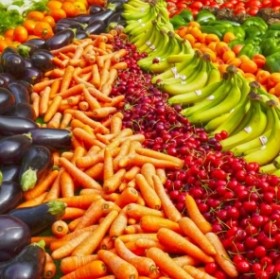 2018-19 School Food Environment Grades
2018-19 School Food Environment Grades
New Report Card Grades Maryland School Districts' Commitment to Improving Nutrition and Ensuring Access to Safe Water in Schools
June 25, 2019
On Healthy School Food Maryland's third release of our
School
Food Environment Grades for the 24 public
school districts in Maryland, there was an 84-point overall increase in grades statewide. This translates to an 8% overall improvement since 2016.
Since we began issuing the grades, there has been consistent incremental progress. In collaboration
with Friends of the Earth, we added a category on the availability of healthy vegetarian and
plant-based options this year, because students and their families are increasingly asking for healthy,
plant-rich options. We found that school districts earned 45% of possible points for this category, on average.
Top marks this year again went to Howard County Public Schools, the only district to receive an A+,
followed again by Anne Arundel (A from A-) in 2nd place, improving half a letter grade over last year. Frederick,
Kent and Saint Mary’s Counties and Baltimore City tied for 3rd place. Frederick also impressed us with their
commitment to Farm to School, by developing a comprehensive Action Plan to integrate locally grown fruits and
vegetables into all FCPS meals. Congratulations also to Baltimore City, which raised its grade from B to B+,
due to overall improvement and because it was the only school district to score 4 out of 4 for plant-based options.
Montgomery County also climbed 2 spots in the rankings and improved its grade from a C+ to a B!
The state's remaining largest school districts, Baltimore County (B-) and Prince George's County (D)
raised their raw scores, but didn’t improve as much as other counties did, which affected their ranking.

The grades are based on a
rubric of 13 items,
with scores ranging from 0-4, which address parent and public health concerns related to school food and wellness,
such as reducing sugar; access to potable water and water bottles; farm to school programs;
salad bars and cut up fruit; use of artificial colors, flavors and other chemical additives;
scratch cooking; availability of plant-based and vegetarian options; variety and repetition of meals;
healthier vending options; transparency; wellness committees; policies on food and beverage marketing;
and availability of vegetarian and plant-based options.
Rubric areas with notable score increases since last year include: Ŕ la Carte Transparency
(up 9 points); General Transparency (up 4 points); Farm to School Programs (up 8 points);
Food and Beverage Marketing Programs (up 7 points); and 43 points (45% of possible points)
earned statewide in the new category, Vegetarian and Plant-based Options.
|
Another concern is elevated lead levels in water in some district schools and the steps schools are taking to protect schoolchildren. Only two counties--Frederick and Kent Counties--obtained the highest score for expressly allowing personal water bottles and putting water bottles on their school supply lists. Other districts have either done nothing, or worse, forbidden students from bringing personal water bottles to school. Dr. Mia Sidhu, pediatrician and HSFM Board Member says, “Most schools have some lead in their plumbing or fixtures; and since we now know that even very low levels of lead in blood can cause cognitive, behavioral, and other health problems, students should be allowed and encouraged to access water at certified filtered filling stations.”.
While most of the items on the rubric are under the control of
food services leadership, at least two rubric areas are decided at a
higher level. This includes rubric items about wellness committees
or school health councils, their composition, power and
transparency; and policies on junk food marketing included in
district-wide wellness policies, required under the Healthy,
Hunger-free Kids Act of 2010 (HHFKA).
 2018-2019 Scorecard
2018-2019 Scorecard
Supporting Documentation
2017-2018 Scorecard
2016
Scorecard
You can support the work of Healthy School Food Maryland,
including the continuation of the School Food Environment Grades
project,
through a donation. Your donation is tax-deductible through
our fiscal sponsor, the non-profit Chesapeake Institute for Local Sustainable Food
and Agriculture. You can donate via PayPal below or via check made
out to "HSFM" and mailed to
Healthy School Food Maryland |